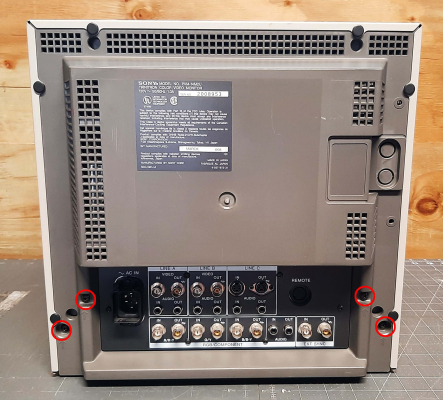(under construction)
Table of Contents
Safety Warning
CRT TVs (like any electronics which are powered from a wall outlet) contain high voltage which can be hazardous when safety precautions are not taken. Ensure you unplug the PVM from the wall before attempting to service it. Follow all warnings and guidelines in the service manual for your monitor regarding safety precautions for servicing. If you are unsure how to properly follow these directions, do not attempt to service your CRT.
CRTs themselves retain energy for extended periods of time after being powered off and unplugged. Power supplies are also known to retain voltage for some time. As an extra precaution, you are advised to wait several hours for this latent energy to discharge before attempting to service your monitor. There are safe ways to expedite this discharge process (see below).
Removing the Rear Case / Shell
Start by removing the side screws - usually there are six total - three on the left and 3 on the right. Next, remove the rear screws. Usually there are four and they are near the input section, and they are all marked with arrows. DO NOT REMOVE THE PLASTIC RIVETS FROM THE REAR OF THE PVM.
Once you've removed all of the screws (and NOT the plastic rivets!), the case is ready to come off. Sometimes they are stiff/tight, but most should come off easily by first turning the PVM away from you (so you are facing the rear), and then pulling the whole rear shell towards you. Sometimes lifting the PVM a little off the table will help finesse it off. If it refuses to budge, sometimes some strategic whacks along the seam where the plastic bezel meets the metal rear shell will break it loose.
Discharging the CRT
Most Sony PVMs (when working properly) are designed to be self-discharging and do not retain energy in the CRT after being powered off. However there are cases where they don't, so even an experienced service technician will still take the proper safety precautions and double-check the CRT is discharged before service, using a discharge probe. Any high voltage probe rated for 20kV is safe to use for both measuring a live CRT's high voltage and discharging it. To discharge the CRT with a probe, you simply attach its grounding clip to the CRT's grounding strap or any metal part of the monitor chassis that has continuity with the tube's DAG coating (the black paint on the back of the CRT's glass envelope). Once ground is attached, you slip the tip of the probe under the anode rubber cap until you make contact with the metal conductor at its center. If the CRT had any voltage, you will hear a sizzle or zap as the electricity jumps from the anode to your probe tip, discharging to ground.
If you want to be extra safe, you can buy insulated gloves rated for high voltage (class 0). This is unnecessary but I will mention it here for those that want to take all possible precautions.
A Note on DIY Screwdriver Discharge Tools
It is a popular suggestion online these days to just use a flathead screwdriver as a discharge tool. Although it is understandable to want to avoid buying an expensive tool for a task you only plan to do a few times, it is important for you to understand the risks associated with it so that you can make the best decision for your own safety. I do not personally recommend this DIY method.
There are two main reasons a high voltage probe is recommended for discharging:
- It is designed to be longer than the arc length of 20kV live voltage, and none of its parts are conductive (other than its tip, obviously). This means your hand can't possibly get electrocuted during any proper use of the tool. Conversely, when you use a screwdriver you must ensure the handle of the screwdriver is completely insulated from the metal shaft of the screwdriver. Electricity will travel the whole length of the screwdriver shaft, which brings it much closer in distance to your bare hand than is recommended in safety guidelines.
- It contains an internal bleeder resistor to allow the discharge process to happen at a lower current, which is safer. Using a screwdriver is like touching a bare wire from the anode to ground. It will instantly zap all the electricity from the tube through the screwdriver to ground. This is dangerous.
Service Positions
P Board
(under construction)
A Board
(under construction)
Removing the P board
(under construction)
Removing the A board
(under construction)



 This work is licensed under a
This work is licensed under a